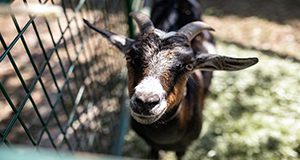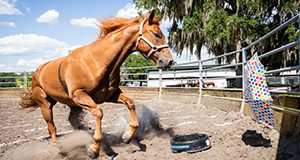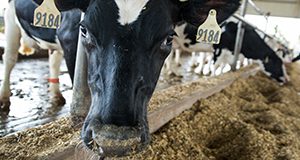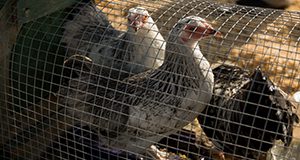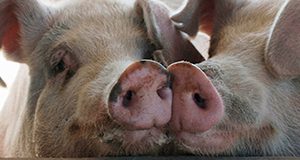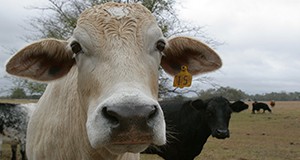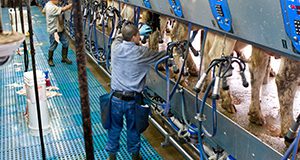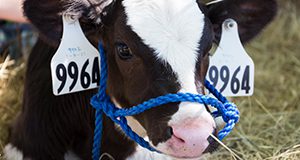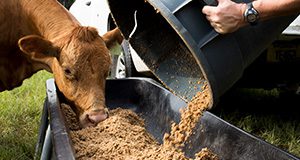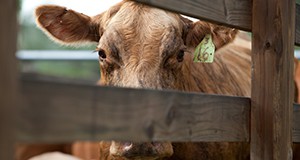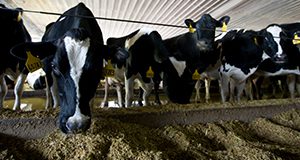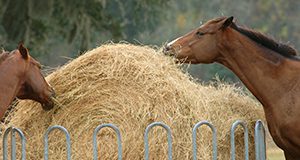This 3-page publication provides a brief overview of resistance to gastrointestinal nematode infections in Florida Native sheep. Written by Zaira M. Estrada Reyes, Owen Rae, Carol Postley, and Raluca G. Mateescu, and published by the UF/IFAS Department of Animal Sciences, August 2020.
https://edis.ifas.ufl.edu/an361
Tag: Animal Sciences Department
Common Hazards Associated with Sheep and Goat Feed
This 7-page document provides a list of common hazards to consider in the manufacturing of feed for small ruminants. Written by Chalise Brown, Diwakar Vyas, and Jason M. Scheffler, and published by the UF/IFAS Department of Animal Sciences, November 2020.
https://edis.ifas.ufl.edu/an363
Anhidrosis in the Horse (Non-Sweaters)—What Do We Know?
This 3-page document provides an overview of anhidrosis in horses, including symptoms and management tips. Written by Laura Patterson-Rosa, Martha F. Mallicote, Robert J. MacKay, and Samantha A. Brooks, and published by the UF/IFAS Department of Animal Sciences, October 2020.
https://edis.ifas.ufl.edu/an362
Advantages and Disadvantages of Various Dry-off Methods for Dairy Cows
This 6-page document reviews advantages, disadvantages, and cost of four dry-off methods and gives recommendations for practical dry-off management. Written by Pornpamol Pattamanont, Marcos Marcondes, and Albert De Vries, and published by the UF/IFAS Department of Animal Sciences, June 2020.
https://edis.ifas.ufl.edu/an360
Raising Backyard Chickens for Eggs
Raising backyard chickens is an increasingly popular way to explore self-sufficiency, connect with how our food is produced, and gain experience for future dabbling in food production. This 13-page publication is designed primarily for those considering raising backyard chickens for eggs for personal consumption. Written by Mary E. Henry, Jessica M. Ryals, Alicia Halbritter, and Derek L. Barber, and published by the UF/IFAS Department of Animal Sciences, revised November 2019.
http://edis.ifas.ufl.edu/an239
Common Hazards to Consider during Manufacturing of Feeds for Swine
This 8-page document discusses common biological, chemical, and physical hazards that may need preventive measures during the manufacture of swine feeds. Written by Taylor Langford, Morgan McKinney, Chad Carr, and Jason M. Scheffler, and published by the UF/IFAS Department of Animal Sciences, September 2019.
http://edis.ifas.ufl.edu/an357
Identificacion del Estres Termico en Vacas Lecheras
El estrés térmico ocurre cuando el calor producido por los procesos biológicos y el calor absorbido del ambiente excede la capacidad de la vaca para perder calor. This 2-page document is the Spanish version of AN356, Recognizing Heat Stress in Dairy Cows. Written by Izabella Toledo and Geoffrey Dahl, and published by the UF/IFAS Department of Animal Sciences, October 2019.
http://edis.ifas.ufl.edu/an358
How Are Cows Cooled on Dairy Farms in Florida?
While hot and humid conditions cause grief for dairy producers, additional impacts of heat and humidity on the dairy cow are sometimes overlooked. These conditions and their associated losses in productivity pose a growing concern to dairy producers, as more frequent and severe fluctuations in temperature, precipitation, and droughts are predicted to occur in the United States. This new 4-page document discusses heat stress in the dairy industry, the Florida dairy heat stress abatement survey, and heat stress abatement for lactating cows, dry cows, and dairy calves. Written by Bethany Dado-Senn, Geoffrey E. Dahl, and Jimena Laporta, and published by the UF/IFAS Department of Animal Sciences, April 2019.
http://edis.ifas.ufl.edu/an355
The Consequence of Postpartum Uterine Disease on Dairy Cow Fertility
This new 4-page document discusses the reproductive consequences of uterine disease in the dairy cow, potential mechanisms, and current treatments. Written by Rachel L. Piersanti and John J. Bromfield, and published by the UF/IFAS Department of Animal Sciences, March 2019.
http://edis.ifas.ufl.edu/an354
Economic Selection Indices: The Best Tool for Dairy Cattle Selection
An economic selection index combines multiple traits into a single value, facilitating the identification of the best animals. This new 3-page document discusses economic selection indices, their changes in the US, and a 2018 update. Written by Francisco Peñagaricano, and published by the UF/IFAS Department of Animal Sciences, March 2019.
http://edis.ifas.ufl.edu/an353
La Ley de Modernizacion para la Seguridad Alimentaria (FSMA): Controles Preventivos para los Alimentos de Animales
La Ley de Modernización de la Seguridad Alimentaria (FSMA) se convirtió en ley en enero de 2011 y se considera la reforma más amplia de las normas de seguridad alimentaria en 70 años. Primero, se establecieron las regulaciones sobre alimentos para el consumo humano luego con la contribución de la industria, la academia, y los consumidores y otras agencias, se modificaron para adaptarse mejor a la producción de alimentos para animales. En Florida, estas nuevas regulaciones se aplican a las instalaciones que fabrican, procesan, empacan o almacenan alimentos o ingredientes para animales. El objetivo principal de estas regulaciones es garantizar alimentos seguros para los animales, las personas que manejan el alimento y las personas que consumen productos derivados de animales. This 4-page document is the Spanish version of The Food Safety Modernization Act (FSMA) Preventive Controls for Animal Food. Written by Francisco Rivera, Chad Carr, and Jason M. Scheffler, and published by the UF/IFAS Department of Animal Sciences, February 2019.
http://edis.ifas.ufl.edu/an352
Antibiotic Use and Resistance for Beef Cattle Producers
Antibiotic-resistant microorganisms cause millions of illnesses and cost billions of dollars in the United States each year. This 5-page fact sheet written by Chad Carr, Matt Hersom, K. C. Jeong, Nicolas DiLorenzo, Jason Scheffler, Victoria Roberts, Gina Faniola, Stephanie Miller, Haley Denney, Nahilia Williams, and Bianca McCracken and published by the UF/IFAS Department of Animal Sciences discusses the use of antibiotics in cattle production operations and answers some common questions about antibiotics and antibiotic-resistant microorganisms.
http://edis.ifas.ufl.edu/an351
The Value of Milk Fat
In the Southeast, milk is priced based on fat and skim milk value, with additional bonuses for somatic cell and bacterial counts. In recent years, butterfat has become more valuable. This 7-page document discusses some of the history behind the changes in milk fat consumption, management factors that influence milk fat content and yield by dairy cattle, and economic implications of changing fat content through the diet in two case scenarios. Written by José E. P. Santos and Albert De Vries, and published by the UF/IFAS Department of Animal Sciences, January 2019.
http://edis.ifas.ufl.edu/an350
Are Cows Comfortable in Modern Dairy Facilities?
The main challenge of modern large dairy operations is to achieve high milk yield per cow without sacrificing health and welfare. Properly designed and managed facilities allow calves, heifers, and cows to be comfortable and successfully grow, mature, maintain health, and reach peak performance. This 8-page document discusses facilities, cow comfort, resting behavior, feed and water access and availability, stocking density, and heat stress. Written by Izabella Toledo, and published by the UF/IFAS Department of Animal Sciences, December 2018.
http://edis.ifas.ufl.edu/an349
Methods of Trace Mineral Supplementation
The forage cattle consume as the bulk of their diet is often deficient in trace mineral concentrations. Cattle producers can choose from a number of different methods to provide supplemental trace minerals to cattle. This 3-page document discusses several common ways to provide trace mineral supplements as well as their advantages and disadvantages. Written by Matt Hersom and Todd Thrift, and published by the UF/IFAS Department of Animal Sciences, October 2018.
http://edis.ifas.ufl.edu/an348
What Is the Economic Impact of Infertility in Beef Cattle?
Producers cannot completely control infertility in their cow herds. However, understanding and addressing the factors that affect infertility will help producers implement management practices that can improve fertility and reduce the negative impacts of infertility on the profitability of beef cow-calf operations. This 4-page fact sheet discusses reasons why beef cows fail to become pregnant or wean a calf, identification of infertile beef cows, and economic impacts of reduced fertility and infertility in beef cattle. Written by Chris Prevatt, G. Cliff Lamb, Carl Dahlen, Vitor R. G. Mercadante, and Kalyn Waters, and published by the UF/IFAS Department of Animal Sciences, revised September 2018.
http://edis.ifas.ufl.edu/an208
How to Measure Body Condition Score in Florida Beef Cattle
Body condition score (BCS) is both a good indicator of the past nutritional status of a cow and a way to determine future nutritional needs. The BCS technique is easy to learn and can help with management decisions. This new 5-page fact sheet discusses reasons to measure BCS, ways to evaluate BCS, and important assessment times. Written by Matt Hersom and Todd Thrift, and published by the UF/IFAS Department of Animal Sciences, August 2018.
http://edis.ifas.ufl.edu/an347
Economic Evaluation of Dairy Cow Stocking Density
What is the optimal number of dairy cows in a pen after their transition period? This 4-page document discusses the economically optimal stocking density for lactating dairy cows, measured as maximum profit per stall. It also introduces a spreadsheet that can be used to calculate the effects of various inputs on the economically optimal stocking density. Written by Albert De Vries, Haile Dechassa, and Henk Hogeveen, and published by the UF/IFAS Department of Animal Sciences, August 2018.
http://edis.ifas.ufl.edu/an346
Riesgos Comunes a Considerar Durante la Manufactura de Alimentos para Caballos
El decreto de Modernización de la Seguridad Alimentaria (FSMA por sus siglas en inglés) fue firmado en Enero del 2011. Dicho documento intenta cambiar el enfoque de la seguridad alimentaria hacia prevención en lugar de reacción ante eventos relacionados con alimentos. Determinar si un peligro requiere un control preventivo depende de la frecuencia y la gravedad del peligro, el cual varía de acuerdo a la instalación y la especie alimentada. This 5-page fact sheet is the Spanish version of EDIS document AN344, Common Hazards to Consider During Manufacturing of Feeds for Horses. Written by Ana Margarita Arias, Taylor N. Langford, Carissa Wickens, Lori Warren, and Jason M. Scheffler, and published by the UF/IFAS Department of Animal Sciences, July 2018.
http://edis.ifas.ufl.edu/an345
Common Hazards to Consider During Manufacturing of Feeds for Horses
Horses are uniquely sensitive to fumonisin and ionophores compared to other livestock species. Facilities, particularly mixed-species feed facilities, need to ensure CGMPs, SOPs, and possibly preventive controls are implemented to address those concerns in addition to more general hazards. This 5-page fact sheet discusses common biological, chemical, and physical hazards in horse feeds as well as methods of prevention. Written by Jason M. Scheffler, Taylor N. Langford, Carissa Wickens, and Lori Warren, and published by the UF/IFAS Department of Animal Sciences, June 2018.
http://edis.ifas.ufl.edu/an344

